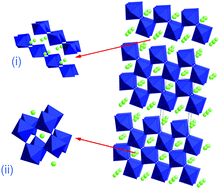Structural characteristics of the (Y1−xLax)2Ti2O7 system have been determined using time-of-flight (TOF) neutron and constant wavelength powder X-ray diffraction (XRD), scanning electron microscopy (SEM), electron probe micro-analysis (EPMA) and 89Y (I = ½) magic-angle spinning nuclear magnetic resonance spectroscopy (MAS NMR). Lattice parameters obtained from neutron data suggest that a pyrochlore (Fd![[3 with combining macron]](https://www.rsc.org/images/entities/char_0033_0304.gif) m, Z = 8) solid solution exists from x = 0 to x = 0.134, whereupon a monoclinic La2Ti2O7-type phase (P21, Z = 4) exsolves. Both phases coexist for 0.134 ≤
x
≤ 0.807 and a single-phase solid solution with the monoclinic structure is stable for x > 0.807. Unit cell volumes from X-ray diffraction of samples synthesised within the pyrochlore regime show excellent agreement with the expected linear increase in unit cell volume across a solid solution, increasing from 1028.46 Å3 for Y2Ti2O7 to 1037.49 Å3 for (Y0.90825La0.09175)2Ti2O7. The limit of the monoclinic solid solution as observed by XRD is higher than that found from neutron diffraction (0.88 compared to 0.807), but this difference is attributed to variation in the sintering temperatures employed. Spectral analysis of NMR spectra for Y-rich compositions suggests that increasing proportions of La are incorporated onto the pyrochlore A-site randomly, up to the limit of solid solution. The NMR spectra of the monoclinic phase show four resonances – two broad and two sharp. These have been attributed to the four crystallographically distinct ‘A’-type sites within the structure. At lower Y concentrations, the sites corresponding to the broad NMR resonances are preferentially occupied. We have tentatively assigned these broad resonances to the ‘slab-edge’ sites in the monoclinic perovskite structure, based on their relatively small size and lower average coordination numbers compared to the perovskite-like sites within the centre of the slabs.
m, Z = 8) solid solution exists from x = 0 to x = 0.134, whereupon a monoclinic La2Ti2O7-type phase (P21, Z = 4) exsolves. Both phases coexist for 0.134 ≤
x
≤ 0.807 and a single-phase solid solution with the monoclinic structure is stable for x > 0.807. Unit cell volumes from X-ray diffraction of samples synthesised within the pyrochlore regime show excellent agreement with the expected linear increase in unit cell volume across a solid solution, increasing from 1028.46 Å3 for Y2Ti2O7 to 1037.49 Å3 for (Y0.90825La0.09175)2Ti2O7. The limit of the monoclinic solid solution as observed by XRD is higher than that found from neutron diffraction (0.88 compared to 0.807), but this difference is attributed to variation in the sintering temperatures employed. Spectral analysis of NMR spectra for Y-rich compositions suggests that increasing proportions of La are incorporated onto the pyrochlore A-site randomly, up to the limit of solid solution. The NMR spectra of the monoclinic phase show four resonances – two broad and two sharp. These have been attributed to the four crystallographically distinct ‘A’-type sites within the structure. At lower Y concentrations, the sites corresponding to the broad NMR resonances are preferentially occupied. We have tentatively assigned these broad resonances to the ‘slab-edge’ sites in the monoclinic perovskite structure, based on their relatively small size and lower average coordination numbers compared to the perovskite-like sites within the centre of the slabs.

You have access to this article
 Please wait while we load your content...
Something went wrong. Try again?
Please wait while we load your content...
Something went wrong. Try again?
![[3 with combining macron]](https://www.rsc.org/images/entities/char_0033_0304.gif) m, Z = 8) solid solution exists from x = 0 to x = 0.134, whereupon a monoclinic La2Ti2O7-type phase (P21, Z = 4) exsolves. Both phases coexist for 0.134 ≤
x
≤ 0.807 and a single-phase solid solution with the monoclinic structure is stable for x > 0.807. Unit cell volumes from
m, Z = 8) solid solution exists from x = 0 to x = 0.134, whereupon a monoclinic La2Ti2O7-type phase (P21, Z = 4) exsolves. Both phases coexist for 0.134 ≤
x
≤ 0.807 and a single-phase solid solution with the monoclinic structure is stable for x > 0.807. Unit cell volumes from 

 Please wait while we load your content...
Please wait while we load your content...